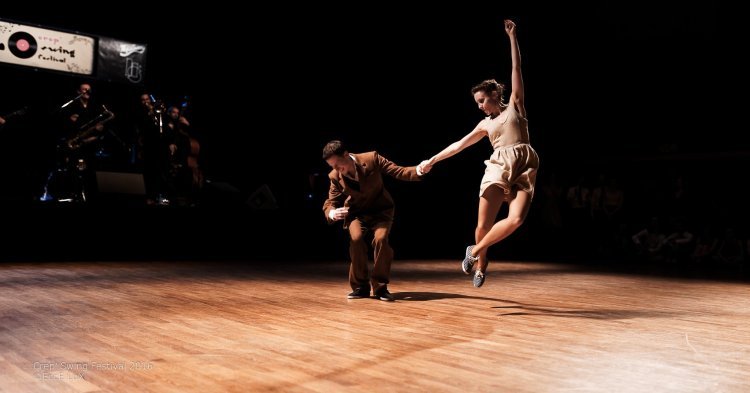Smooth oodles of jazz envelope the many hundreds of dancing guests. The saxophone sears high, floating and intense; the piano tinkers almost mockingly, alight with easy extravagance; the deep pulsing bass holds the room in the power of its lively, inviting rhythm. The magnificent Stadthalle of Heidelberg glitters with a gleam untouched by the centuries; for four days each year, it is home to one of the biggest swing dance festivals in Europe, attracting some of the best jazz bands, some of the best dancers, and many more less gifted but equally energetic enthusiasts.
Snatches of conversation in many different languages can be glimpsed between the dancers taking a break around the edges of the beautifully frictionless, utterly packed dance floor. Many have adopted a vintage style concurrent with the 1930s origins of the dance; a colourful hairband, braces, or a tweed cap add the finishing touches to many outfits.
Lindyhop is a partner dance which originated in Harlem, New York between the two World Wars. It’s a fun, dynamic, open style of dancing, based on cheerful syncopated swing rhythms in which healthy dollops of improvisation and musicality can be satisfactorily blended with iconic moves. Its sister, the Charleston, which has recently gained some more widespread fame thanks to TV shows such as “Strictly Come Dancing” in the UK or “Danse avec les Stars” in France, is fit for faster music. Both dances are being keenly embraced by an increasing number of communities across Europe and creating connections between dancers of many different nationalities.
Swing dancing has long promoted integration. In New York’s famous Savoy Ballroom, which housed the pioneers of lindyhop and the best live jazz the world had to offer seven nights a week, there was a strict no discrimination policy, and people of all skin colours danced together – at a time where racial segregation was still an everyday reality. Today in Europe, international festivals gather dancers and musicians of many different cultural origins, with many offering classes in English to make them more or less accessible for visitors as well as locals. However, it’s important to remember that, while Lindyhop gathers mainly white and often fairly middle-class dancers in Europe today, both the dance and the music have their roots in African-American communities in the US, who may have thrown their hearts into their passion for swing as an escape from the harsh discrimination they faced outside of the Savoy.
Many events strive explicitly to create links between dancers in different countries. Swing “exchanges” are events where dancers gather in a host city to enjoy evenings of social dancing, without classes or competitions. The host dancing community will do its best to welcome visiting dancers, most of whom they have never met, and with whom they may or may not share a common language, into their own homes.
The Quattropole, an exchange which takes place over two weekends in four different cities (Metz, Luxembourg City, Saarbrücken and Trier), straddles several national borders and brings together dancers from all over Europe for a glimpse into the local dancing communities in bordering countries. The event promotes “one community crossing borders, cultures, languages, dancing together to the same rhythm of love, kindness, openness. All things we need now more than ever.” Needless to say, such events would not be possible without the freedom of movement of people which allows musicians, instructors and dancers to travel and work freely across borders.
Swing dancing isn’t exactly challenging the UEFA European Championships for popularity, but this niche activity has grown a pan-European subculture and community all of its own. Cheesy as it might sound, swing really does have the power to help Europeans forge international friendships and bring people of different corners of the continent together through a shared passion. Dancing might be on hold due to its rather unfortunate incompatibility with social distancing, but dancers across Europe and beyond are tapping their feet with impatience. We’ll be back into the swing of things in no time.


Follow the comments: |
|
